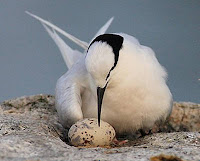 As many of you already know, the New Jersey Marine Fisheries Council discontinued the state's moratorium on harvesting horseshoe crabs. The NJMFC will allow a harvest of up to 150,000 male horseshoe crabs despite the advice of the state's Department of Environmental Protection and despite overwhelming support for the moratorium from residents who submitted public comments on the issue. Commercial representatives who control the council killed the moratorium:
As many of you already know, the New Jersey Marine Fisheries Council discontinued the state's moratorium on harvesting horseshoe crabs. The NJMFC will allow a harvest of up to 150,000 male horseshoe crabs despite the advice of the state's Department of Environmental Protection and despite overwhelming support for the moratorium from residents who submitted public comments on the issue. Commercial representatives who control the council killed the moratorium:
The five votes to veto the ban all came from members of council that represent the commercial fishing industry, including Erling Berg, Barney Hollinger, John Maxwell, Frances Puskas, and Joe Rizzo. The four votes to keep the ban came from members who represent the recreational fishing industry, including Patrick Donnelly, Ed Goldman, Dick Herb and Chairman Gil Ewing. The two public-at-large positions on council are vacant and could have made a difference in the vote.
There is still a chance to stop horseshoe crab harvests. The legislature can override the NJMFC, or the governor could impose an emergency moratorium. This will only happen if there is pressure from birders and environmental organizations.
I am sending the following letter to Senator Bob Smith, Assemblymen Upendra Chivukula and Joseph Egan, and (with modifications) Governor Jon Corzine. I suggest that other New Jersey residents send letters as well. You can contact your legislators
here and the governor
here. Readers may use this letter as a template. (Or, better yet, compose your own letters.)
Web Resources
Since this is a state government issue, letters will be most effective coming from New Jersey residents.
Birdchick has a suggestion for people outside New Jersey.
Update: According to Jim Wright,
a reprieve may be on the way. It is still a good idea to let public officials know that this is an important issue for a lot of New Jersey residents.
Further update: The state government is
considering ways to extend the harvest moratorium. The governor is considering an executive order, and there should be a bill for a permanent moratorium in the legislature. Continuing to write letters on the subject could help ensure that one or the other happens.
*****
On Monday, February 11, the New Jersey Marine Fisheries Council (NJMFC) voted against continuing the state's moratorium on the harvest of horseshoe crabs (
Limulus polyphemus). By a 5-4 vote, the Council decided instead to allow harvesting of up to 150,000 male horseshoe crabs. I am writing to ask that you override the decision of the NJMFC and reimpose the moratorium by legislative action.
As you may be aware, horseshoe crabs are a key link in one of New Jersey's great natural spectacles. Each year, small birds called red knots (
Calidris canutus rufa) make a 9,300-mile journey from their winter territory in Tierra del Fuego to their breeding grounds in the Arctic. In May and June, they stop along the shore of the Delaware Bay to feast on the newly-laid eggs of horseshoe crabs. Without this vital food, red knots may not have sufficient energy to breed or even complete their journey.
Red knots have lost approximately 80% of their population since 1990 due to overharvesting of horseshoe crabs. Biologists estimate that red knots require about 50,000 eggs per square meter of beach. Currently, egg density is only 2,000 per square meter, and less than half of red knots are reaching the proper weight for migration and breeding. Computer models predict extinction as soon as 2010. The red knot is a candidate for listing under the federal Endangered Species Act, and New Jersey's Department of Environmental Protection (NJDEP) has already named the bird as a state endangered species.
The harvest limit imposed by the NJMFC is inadequate for conserving red knots. Its limit of 150,000 in New Jersey exceeds that suggested the Atlantic States Marine Fisheries Commission, which instructed states to limit harvests to 100,000 males. There is little indication of how this limit would be enforced, or whether watermen would be prevented from harvesting males during copulation. Moreover, the NJMFC's action rejects the NJDEP's proposal - based on the best science available - to extend the moratorium.
The red knot's condition is clearly dire, and immediate action is needed to prevent the species from becoming extinct. New Jersey should continue its moratorium on horseshoe crab harvests until there is clear evidence that red knot populations have stabilized and begun to recover. Since the NJMFC will not do this, the state government must intervene.
 Defenders of Wildlife petitioned the U.S. Fish and Wildlife Service for emergency listing of the Red Knot under the Endangered Species Act due to new data showing further population declines. Senators Menendez and Lautenberg are publicly supporting the petition. A moratorium bill is moving through the New Jersey Assembly.
Defenders of Wildlife petitioned the U.S. Fish and Wildlife Service for emergency listing of the Red Knot under the Endangered Species Act due to new data showing further population declines. Senators Menendez and Lautenberg are publicly supporting the petition. A moratorium bill is moving through the New Jersey Assembly. A small Fijian island has managed to eradicate the introduced rats that were preying on nesting seabirds such as Black Noddy (Anous minutus), Bridled Tern (Sterna anaethetus), and Black-naped Tern (Sterna sumatrana).
A small Fijian island has managed to eradicate the introduced rats that were preying on nesting seabirds such as Black Noddy (Anous minutus), Bridled Tern (Sterna anaethetus), and Black-naped Tern (Sterna sumatrana).
































